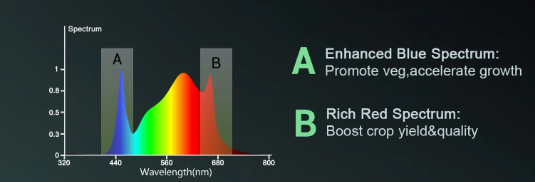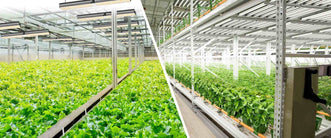The Top 6 Benefits of Using Full Spectrum LED Grow Lights for Your Plants
Full spectrum LED grow lights have revolutionized the way we grow plants indoors. These lights provide the complete range of light required for plants to grow and thrive. Unlike traditional grow lights that emit only a specific spectrum of light, full spectrum LED grow lights mimic the natural sunlight, providing all the necessary wavelengths that plants need for photosynthesis.
In this article, we will discuss the top 10 benefits of using full spectrum LED grow lights for your plants. From faster growth and better yields to lower energy consumption and longer lifespan, we will explore why full spectrum LED grow lights are the ideal choice for indoor gardeners and commercial growers alike. Whether you're growing herbs, vegetables, or flowers, full spectrum LED grow lights offer a host of advantages that can help you achieve better results and save time and money in the long run.

Full Spectrum LED Grow Lights vs. Other Types of Grow Lights
Full Spectrum LED grow lights are considered to be the most advanced form of grow lights on the market today. They have become increasingly popular in recent years due to their efficiency, effectiveness, and versatility. Unlike other types of grow lights, Full Spectrum LED grow lights emit a wide range of wavelengths that are optimized for plant growth, including both red and blue light wavelengths that plants need for photosynthesis. These lights are also highly energy efficient, allowing growers to save on electricity costs.
In comparison, other types of grow lights, such as high-pressure sodium(HPS) and metal halide (MH) lights, emit a more limited range of wavelengths that are not optimized for plant growth. These lights tend to emit a lot of heat, which can be problematic for indoor growers who need to maintain consistent temperatures. They are also not as energy efficient as Full Spectrum LED grow lights, meaning that they will cost more to run over time.
Benefits of Full Spectrum LED Grow Lights

Enhance Plant Growth and Yields
LED (Light Emitting Diode) grow lights have revolutionized the way we grow plants, especially indoors. One of the most significant benefits of using LED grow lights is their ability to enhance plant growth and increase yield. This is because LED grow lights are designed to emit specific wavelengths of light that plants need for photosynthesis. Unlike traditional grow lights, which produce a lot of heat, LED grow lights are more energy-efficient and produce less heat, which means they can be placed closer to plants without burning them.
LED grow lights also offer a wide full spectrum of light that can be customized for different plants and growth stages. This means that plants can receive the right amount and type of light they need for each phase of growth, resulting in faster and healthier growth, stronger stems, and larger yields. Additionally, LED grow lights last much longer than traditional grow lights, which means they require less frequent replacement, making them a more cost-effective option in the long run.
Better Quality of Crops
LED grow lights have revolutionized the way we cultivate crops, offering a range of benefits over traditional lighting sources such as incandescent bulbs and fluorescent tubes. One of the most significant benefits of LED grow lights is their ability to produce a better quality of crops. LED grow lights are highly energy-efficient and provide a specific full spectrum of light that is ideal for plant growth.
Unlike traditional lighting sources, LED grow lights emit less heat, reducing the risk of damage to plants and allowing for more efficient photosynthesis. LED grow lights can also be customized to emit specific wavelengths of light, which can promote specific plant growth stages and improve the overall health and quality of the crop. Additionally, LED lights have a longer lifespan than traditional lighting sources, reducing the need for frequent replacements and resulting in cost savings over time. Overall, LED grow lights provide an excellent option for growers looking to produce high-quality crops while reducing energy consumption and cost.
Increased Energy Efficiency
LED grow lights have become increasingly popular among indoor gardeners due to their many benefits. One major advantage of LED grow lights is that they are highly energy efficient. Unlike traditional grow lights such as HID lamps, which waste a significant amount of energy through heat emission, LED grow lights produce little heat and use far less energy to achieve the same level of light output. This increased efficiency translates into lower energy costs for growers and a reduced carbon footprint. Additionally, LED grow lights have a longer lifespan than traditional grow lights, which means they need to be replaced less frequently, further reducing energy consumption and waste. With LED grow lights, gardeners can achieve high-quality plant growth while saving money on energy bills and reducing their environmental impact.
Long Lifespan and Duration
Another significant benefit of LED grow lights is their longer lifespan and duration. Traditional grow lights, such as HID lamps, typically last between 10,000 to 20,000 hours, while LED grow lights can last up to 100,000 hours. This extended lifespan means that LED grow lights need to be replaced much less frequently, saving growers time and money in the long run. Additionally, LED grow lights maintain their light intensity and spectrum throughout their lifespan, unlike traditional grow lights, which tend to degrade over time. This means that LED grow lights can provide consistent and optimal light conditions for plants, leading to healthier growth and higher yields. With their longer lifespan and duration, LED grow lights are a cost-effective and reliable option for indoor gardening, making them a popular choice among both hobbyist and commercial growers.
Safer for the Environment and Humans
LED grow lights offer several benefits in terms of safety for both the environment and human health. Firstly, LED grow lights do not contain toxic materials like mercury, which is commonly found in traditional fluorescent lights. This makes LED grow lights a safer option for disposal, reducing the risk of harm to the environment. Secondly, LED grow lights emit less heat than traditional grow lights, which reduces the risk of fire and other safety hazards. This is especially important for indoor gardening where ventilation can be limited.
Additionally, LED grow lights do not emit harmful ultraviolet (UV) rays, which can damage the skin and eyes. This means that gardeners can work around the lights without the need for protective clothing or eyewear. Finally, LED grow lights operate on low voltage and require less energy, reducing the risk of electrical shocks and making them a safer option for indoor gardening. Overall, LED grow lights provide a safer and more environmentally friendly option for indoor gardening, ensuring that growers can cultivate their plants without compromising safety or health.
More Versatile and Customizable
Another significant benefit of LED grow lights is their versatility and customizability. LED grow lights come in a range of sizes and shapes, allowing growers to choose a lighting solution that fits their specific indoor gardening setup. Additionally, LED grow lights come with different color full spectrum that can be adjusted to provide the optimal light conditions for different plant growth stages. This allows growers to customize their lighting solutions to match their plant species and growth needs, resulting in healthier plants and higher yields.
LED grow lights also offer greater control over light intensity and duration, which can be adjusted to match the specific needs of different plant species. This level of control allows for precision indoor gardening and can lead to improved crop quality and higher yields. Furthermore, LED grow lights are compatible with various indoor gardening setups, including hydroponics, aquaponics, and vertical farming. This versatility makes LED grow lights a popular choice among both hobbyist and commercial growers, providing them with a range of options to customize their lighting solutions and achieve optimal plant growth.
Factors to Consider When Choosing Full Spectrum LED Grow Lights

The Light Spectrum and PAR Output
When choosing full spectrum LED grow lights, two crucial factors to consider are the light spectrum and photosynthetically active radiation (PAR) output. The light spectrum refers to the range of wavelengths emitted by the LED grow light, which can be adjusted to match the different stages of plant growth. Full spectrum LED grow lights provide a complete range of wavelengths from blue to red, which are essential for plant photosynthesis and growth. The blue light spectrum is beneficial for vegetative growth, while the red spectrum is essential for flowering and fruiting stages. Additionally, some full spectrum LED grow lights come with UV and infrared wavelengths that can aid in plant development and boost overall plant health.
The PAR output is the measurement of light energy that plants can use for photosynthesis, and it is essential to consider when choosing LED grow lights. A higher PAR output means that the plants are receiving more light energy, which can result in faster growth and higher yields. However, the PAR output should be matched to the size and intensity of the LED grow light, as too much light can cause damage to plants. It is essential to consider the PAR output of LED grow lights when designing an indoor gardening setup to ensure that the plants receive the optimal amount of light for their growth stage. Overall, the light spectrum and PAR output are crucial factors to consider when selecting full spectrum LED grow lights, as they can impact the quality and quantity of plant growth.
The Wattage and Coverage Area
When it comes to selecting full spectrum LED grow lights for your indoor plants, there are several factors to consider, including wattage and coverage area. Wattage refers to the amount of power that the LED grow light uses, and it plays a crucial role in the growth and development of your plants. Generally, a higher wattage means a stronger and more intense light output, which can help to promote faster growth and better yields. However, it's essential to choose a wattage that is appropriate for your plant's needs and the size of your grow space. For instance, if you have a small grow space, a low-wattage LED grow light may be sufficient, while a larger area will require a higher wattage to cover adequately.
Coverage area is another critical factor to consider when selecting full spectrum LED grow lights. It refers to the amount of space that the light can effectively cover, and it can vary depending on the wattage and the type of plants you're growing. It's crucial to choose an LED grow light that can cover the entire grow area evenly to ensure that all plants receive sufficient light for optimal growth. Additionally, it's essential to consider the height of the full spectrum LED grow light and the distance between the light and your plants. Some LED grow lights have a narrow beam angle and are best suited for taller plants, while others have a wider beam angle and are better for shorter plants or smaller spaces.
The Brand Reputation and Customer Reviews
When choosing full spectrum LED grow lights for your indoor plants, it's important to consider the brand reputation and customer reviews of the products you're considering. A reputable brand is more likely to produce high-quality LED grow lights that are reliable and effective. Established brands often have a track record of producing high-performing products and providing excellent customer service, which can give you peace of mind when making your purchase. Additionally, established brands are more likely to offer warranties and after-sales support, which can be valuable if you encounter any issues with your full spectrum LED grow light.
Customer reviews can also be an invaluable resource when selecting full spectrum LED grow lights. Reading feedback from other growers who have used the product can provide valuable insights into the performance, reliability, and ease of use of the LED grow light you're considering. Look for reviews from other growers who have similar plants and growing environments to yours to get a better idea of how the LED grow light will perform in your setup.
To Sum Up…
In conclusion, using full spectrum LED grow lights for your plants offers a wide range of benefits that can help optimize plant growth and development. And investing in full spectrum LED grow lights can significantly improve the quality and yield of your plants, making it a valuable addition to any indoor gardening arsenal. If you have any other questions about full spectrum LED grow light, please feel free to contact us.







































